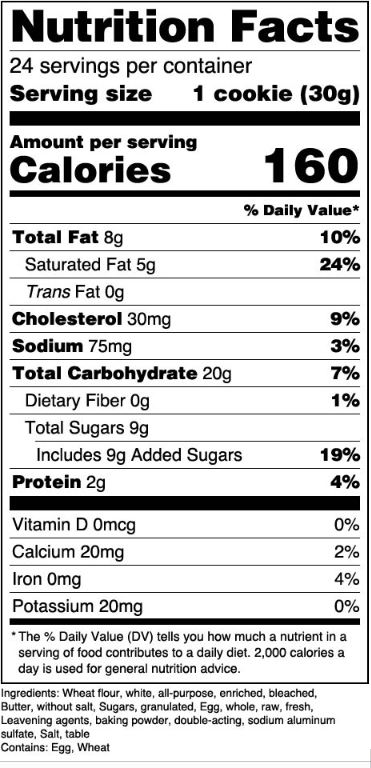
The amount of misinformation out there about proper nutrition is mind-boggling. From mislabeling, fad diets, and fake supplements, corruption runs deep. Unfortunately, nutrition is not typically taught in schools and most people do not know right from wrong. My goal is to change that.
Let’s start with the basics of how to read a nutrition label:

This is an example of a modern nutrition label as regulated by the FDA.
There are 5 sections on a nutritional label: serving information, calorie amount, nutrient information, daily value recommendations, and ingredient list.
This label represents a box of cookies. The serving information section at the top contains the number of servings in a package and the serving size. A serving size is generally standardized so you can compare it to similar foods. All of the nutrient amounts shown on the label refer to the serving size. So, there are 24 servings in this container and 1 serving is 1 cookie. That means each cookie (1 serving) contains the calories and nutrient information below it.
Moving onto the 2nd section, calorie amount. In this example, one cookie would be 160 calories, meaning two cookies are 320 calories.
The 3rd section, nutrient information, is the largest and the most important to pay attention to. Most people just look at the amount of calories in a given food, however, just because a food has a lot of calories does not mean it is bad for it. For example, avocados are calorie-dense but provide a lot of nutritional value including healthy fats, fiber and are high in vitamins and minerals. There is no direct correlation between calorie amount and nutritional value. However, typically foods with more calories contain more fat and sugar, which you want to avoid.
Now let’s break down the nutrients listed in this section:
Total Fat
-
- 1 gram of fat contains 9 calories
- There are 4 types of fat: saturated fat, trans fat, polyunsaturated fat, and monounsaturated fat. You want to avoid excess saturated fats and avoid trans fat altogether. Polyunsaturated and monounsaturated fat are considered healthy and beneficial fats, which is why they are not listed as a subcategory of fats. Any grams of fat that are not listed as saturated or trans, are in this category. These are known as your “omega-3” or fatty acids.
Cholesterol
-
- This is listed in milligrams (mg) and will depict how much cholesterol is in that food. You may want to pay attention to this number if you have high cholesterol or if your doctor recommends eating low-cholesterol food.
Sodium
-
- Similar to cholesterol, the label will list how much sodium, in mg, is in that food. Sodium is a contributor to high blood pressure so you may want to pay attention if you are trying to lower blood pressure. However, sodium is also an electrolyte and is important for athletes or someone who sweats a lot, to consume to stay hydrated.
Total Carbohydrates
-
- 1 gram of carbohydrates contains 4 calories
- There are 3 types of carbs: complex/starch, sugar, and fiber. Complex/starch carbs make up most of the carbohydrate sources in food. These are foods like rice, beans, oats, grains, pasta, etc. Sugar can be broken down further into natural sugar and added sugar. Natural sugar is sugar that is organically found in that food. Most fruits are high in natural sugar. Added sugar is processed sugar that is added to food during production. You want to limit added sugars as much as possible and replace them with natural sugars instead. Fiber is important for digestive health and is very beneficial to incorporate into your daily diet.
Protein
-
- 1 gram of protein contains 4 calories
- Protein is arguably the most crucial micronutrient for health and fitness. This is because protein is used in the muscle-building process and will keep you satiated for much longer. In general, you want to be eating 0.8-1.0 grams of protein per pound of body weight.
Vitamins and Minerals
-
- This will list how much Vitamin D, Calcium, Iron, and Potassium are contained in that food. These are some of the more important vitamins for your body so you want foods high in these nutrients.
The 4th section is Percent Daily Value or DV. This is the percentage of the total recommended intake for that nutrient. This is generally OK for the average person but it is important to remember that this is an overly generic recommendation based on a 2,000-calorie diet. Your specific needs will vary greatly from other people.
The 5th and final section is the ingredient list. This is important to look at if you have a specific allergy to a food. Typically, the shorter the ingredient list, the healthier it is. You want to eat as many whole foods as possible rather than processed.
Now let’s talk about calories.
Calories get a bad reputation for making you gain weight and people will restrict them to the point of starving themselves to lose weight. But that is not the case, your body requires sufficient calories to function, and eating enough is critical to maintaining your overall well-being.
There are 3 types of calorie consumption: deficit, maintenance, and surplus.
Your maintenance calorie amount is the number of calories you need to eat every day to maintain your current body weight. This is your base Resting Metabolic Rate (RMR) or how many calories you burn if you sit around all day and do nothing. This number is based on age, height, weight, gender, and current activity level and is different for everyone.
Eating in a caloric deficit means you are eating below your maintenance calories. This means you will lose weight. A good starting point for weight loss is 300-500 below your maintenance. Any more than that and you risk muscle loss, depleted energy levels, weakened immune system, hunger cravings, lightheadedness, constipation, and weight gain, among a bunch of other negative side effects.
There are plenty of online calculators you can use to find your maintenance so you can gauge how many calories to be eating in order to lose weight. The opposite of a calorie deficit is a surplus which means you eat above your maintenance to gain weight. This is a common practice during the “bulking” phase of weight lifting to gain muscle and overall mass.
The last topic I want to briefly touch on is supplementation.
A supplement’s role is to add or replace something that is naturally occurring in food. There are many different types of supplements out there including multi-vitamins, fish oil, amino acids, etc. Supplements can be helpful if you are not getting enough of a nutrient from your diet. A common deficiency is Vitamin C which you can supplement. However, the FDA does not regulate or approve most supplements, so it is important to talk to your doctor before taking anything to avoid any unwanted side effects.
In conclusion, I want to end by saying “anything in moderation” when it comes to proper nutrition. You should still eat the foods you enjoy as long as you are not eating them in excess. Creating and maintaining a healthy relationship with food is the single most important thing you can do to improve your health, nutrition, and fitness.



